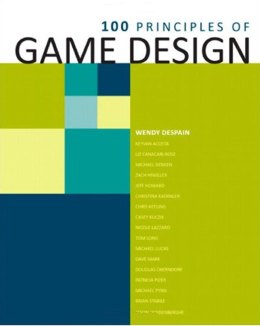Author: Wendy Despain
Publisher: New Riders
Pages: 240
ISBN: 978-0321902498
Audience: Game designers, UI/UX designers
Rating: 4.5
Reviewer: David Conrad
A book that gathers some of the best principle and philosophies of games design into a toolbox of possibilities. How does that work?
The short answer is remarkably well - it really is a treasure trove of ideas from a wide range of disciplines including psychology, economics, artificial intelligence and magic. Each of the hundred principles is explained in a single page, each of which is accompanied by a full page illustration. Many of these are directly relevant and reinforce the text, in other cases they are attractive pictures that help to convey the underlying idea.
Although this book credits seventeen contributors on its cover the individual articles aren't attributed and the main "voice" that comes across is that of the editor, Wendy Despain. In the Acknowledgements she also explains how this work was influenced by Universal Principles of Design by Lidwell et al and that it was written to bridge the gap between Game Design and more general design to meet the needs of students at Full Sail University.
When you have assembled 100 distinct ideas how do you arrange them? Here they are organized into four color-coded sections:
- Universal Principles for Game Innovation (29)
- Universal Principles for Game Creation (32)
- Universal Principles for Game Balancing (18)
- Universal Principles for Troubleshooting (21)
There is also a full alphabetical listing, which is helpful as most of the articles have cross references to others, and an index with over eight hundred entries which also helps you locate the topics you are interested in.
Within each section the articles are also arranged alphabetically - which really is the only option as otherwise what would you choose as the criteria - importance, best-known, most amusing? Any such option would lead to conflict.

So what is in the book? With a hundred separate items to choose from I can't tell you about all of them - but I would like to as all of them deserve mention. For those new to game design the Innovation section includes fundamental distinctions such as Co-operative vs. Oppositional, Memory vs.Skill and looks at Feedback Loops, Outcomes and Payoffs, with pages devoted to the Prisoner's Dilemma and the Volunteer Dilemma. It covers classics such as Bartle's Player Types, Minimax, Nash Equilibrium and the Skinner Box. There are also newer theories such as Koster's Theory of Fun and VandenBerghe's Five Domains of Play.
The Game Creation section is the longest in the book and every article is packed with practical information making it a useful reference to Game Genres, Game Pillars and House Rules. It discusses Brainstorming Methods, Flow, Risk Assessment, Supply and Demand, Synergy and Wayfinding and explains the principles of Metagames, Gestalt and the Core Gameplay Loop. It also has advice for Objects, Attributes, States, for Prototyping and for User-Centered Design.
For those with some experience of game or user interface design the section on Balancing is perhaps the most illuminating. Starting with an article on Addiction Pathways you keep coming across clues to human nature that are key to making a success of human computer interaction (HCI). If you are not already familiar with Maslow's Hierarchy of Needs the article included here explains how this model is relevant to games and there's an illuminating one on Punishment that looks at the role of negative reinforcement in games. Another on Errors Without Punishment looks at how to handle situations in which players don't behave in the way the games designer intended. One principle that user interface designers will find interesting in this section is Hick's Law, a formulation I'd not previously come across, which states that when a user is presented with a list of similar choices the time it takes to decide between them increases logarithmically – so avoid too many high level choices in menus. Good point!
Troubleshooting is the topic of the final section and its collection of topics include ones that are deep as well as fundamental, for example the Golden Ratio, the Zero-Sum Game and Instant vs. Delayed Gratification. There's plenty of psychology here - another principle included us that of Fundamental Attribution Error and - also some ergonomics. Another law I'd not encountered before is Fitts Law referring to the fact that the faster someone moves to point at a target the less accurate the movement becomes.
You might think that a hundred principles would be enough but there is also a bonus, by way of the book's Appendix that provides thirty-five methods for solving problems. Some of these – like Brainstorming and Prototyping essentially cross reference earlier content, while others like Make a List, Draw a Picture and Solve the Opposite Problem haven't already been discussed. Most of the suggested methods are ones you'll have come across, such as – Come at It Sideways or Solve in Parts and Combine – but when you are stuck just consulting this list of possibilities could provide what's needed.
Once you dip into this book you are likely to be hooked, make loads of surprising discoveries and find that it really is a page-turner in that you want to devour more if it.
Recommended - not only for game designers, but for anyone in UI/UX or concerned with human computer interaction.
Software Architecture In Practice
Author: Len Bass, Dr. Paul Clements and Rick Kazman
Publisher: Addison-Wesley Professional
Pages: 464
ISBN: 978-0136886099
Print: 0136886094
Kindle: B094CPJ96B
Audience: Software architects
Rating: 4.5
Reviewer: Kay Ewbank
This is the fourth edition of a book widely regarded as a classic since its firs [ ... ]
|
The Programmer's Brain (Manning)
Author: Dr. Felienne Hermans
Publisher: Manning
Date: September 2021
Pages: 256
ISBN: 978-1617298677
Print: 1617298670
Kindle: B09CQHBVQZ
Rating: 4
Reviewer: Mike James
Programmers have a brain - but what is it doing?
| | More Reviews |
|


